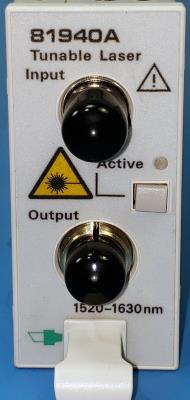
|
|
The Agilent 81940A high power compact tunable laser enables optical device characterization at high power levels and measurement of nonlinear effects. It improves the testing of all types of optical amplifiers and other active components as well as broadband passive optical components. As single slot plug-in modules for Agilent's 8163A/B, 8164A/B and 8166A/B mainframes, they are a flexible and cost effective stimulus for single channel and DWDM test applications. Each module covers a total wavelength range of 110 nm in the C+L-band.
Specifications.
Wavelength range: 1520 nm to 1630 nm.
Wavelength (frequency) resolution: 1 pm, 125 MHz at 1550 nm
Mode-hop free tenability: Full wavelength range.
Maximum sweep speed: 50 nm/s.
Absolute wavelength accuracy: ± 20 pm, typical ± 5 pm.
Relative wavelength accuracy: ± 10 pm, typical ± 5 pm.
Wavelength repeatability: ± 2.5 pm, typical ± 1 pm.
Wavelength stability (typical, over 24 hours): ± 2.5 pm.
Linewidth (typical), coherence control off: 100 kHz.
Effective linewidth (typical), coherence control on: > 50 MHz (1570 nm to 1620 nm).
Maximum output power (continuous power during tuning):
≥ +14.5 dBm peak (typical),
≥ +13 dBm (1570 nm to 1620 nm),
≥ +10 dBm (1520 nm to 1630 nm).
Power linearity: ± 0.1 dB.
Power stability: ± 0.01 dB over 1 hour.
Power flatness versus wavelength: ± 0.2 dB, typical ± 0.1 dB (1570 nm to 1620 nm), ± 0.3 dB, typical ± 0.15 dB (full range).
Power repeatability (typical): ± 0.01 dB.
Side-mode suppression ratio (typical): ≥ 50 dB.
Options.
071, PMF, straight contact output connector.
072, PMF, angled contact output connector.
|